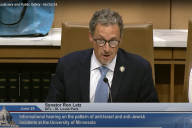You have /5 articles left.
Sign up for a free account or log in.
When low-income students take credit-bearing college courses while still in high school, research has shown they are more likely to graduate from high school, enroll in college and then stick with it.
So-called dual enrollment programs have become increasingly popular, with 1.4 million high school students taking a college course during a recent year. About 2,000 colleges and universities offer dual enrollment, according to the National Alliance of Concurrent Enrollment.
Many states and most colleges subsidize the tuition prices of these programs, the alliance said. But not all do, and fully two-thirds of colleges reported that some parents and students spent money on the tuition for dual-enrollment courses. As a result, the alliance said lower-income students are less likely to take the courses than their wealthier peers.
“Paying for dual enrollment is a big challenge for a lot of students,” said Elizabeth Morgan, director of external relations for the National College Access Network.
In addition, high school students are not able to access federal financial aid to help pay for dual-enrollment courses, because Pell Grants only are available to students who hold a high-school diploma or its equivalent.
The Obama administration wants to change this policy, at least on a limited basis. Last week the U.S. Department of Education announced a plan to open up experimental access to Pell Grants for high school students in dual-enrollment courses.
Colleges and high schools may apply to participate in the program. The department plans to spend up to $20 million on the experiment next year, which it said will go to up to 10,000 students from low-income backgrounds.
Community colleges offer 70 percent of the dual-enrollment courses high school students take each year, according to the department. Jobs for the Future, a nonprofit organization, has published recommendations on what constitutes a good approach to dual enrollment, also identifying states the group says get it right.
“By offering federal Pell Grants to eligible public high school students enrolling in college courses, the administration is expanding opportunities for students to enroll in high-quality dual enrollment programs with robust systems of student support,” the department said in a written statement.
Both Morgan and the National Alliance of Concurrent Enrollment applauded the department’s announcement. But Morgan said opening up Pell Grants to high school students poses a key challenge.
The federal grants come with a 12-semester limit, meaning that students are not eligible to receive Pell Grants after using the aid for 12 semesters. And taking a dual-enrollment course will start the aid clock even while students are still in high school.
As a result, Morgan said, it’s important that dual-enrollment students earn college credits that help move them toward earning a degree or certificate. That’s not always the case. For example, she said a student might pick a dual-enrollment track in hospitality while he or she is only in eighth grade. If the student ends up not pursuing a hospitality credential while in college, those credits might not help the student finish a degree.
"There isn’t a lot of wiggle room,” she said.
The department is aware of this challenge, and tailored the experiment’s requirements toward degree completion. For example, students may only receive Pell Grants for “course work that applies toward completion of a postsecondary credential at the participating institution.”
Last week's announcement is the third so-called experimental site the department has announced this year. And those three follow an earlier, still ongoing experiment, on competency-based education.
Experimental sites are designed to help the feds study the results of waiving certain aid requirements, with an end goal of informing federal aid policy. But the department has rankled some congressional Republicans with its relatively aggressive approach during the waning years of the Obama administration.
For example, in July the department announced that it would make Pell Grants available on a limited basis to incarcerated students. At least 200 colleges have said they’re interested in participating in that experiment.
But Senator Lamar Alexander, the Tennessee Republican who heads the U.S. Senate’s education committee, has said the department is overreaching with the experiment.
“This may be a worthwhile idea for some prisoners, but the administration absolutely does not have the authority to do this without approval from Congress, because the Higher Education Act prohibits prisoners from receiving Pell Grants,” Alexander said in a written statement.
The dual-enrollment experiment has not generated any controversy yet. But dual-enrollment programs are threatened by new accreditation problems, at least in the 19 states that the Higher Learning Commission oversees.
The commission, which is the largest regional accreditor, recently issued a policy clarification that said high school teachers in dual-credit courses must have a master’s degree in the specialty they’re teaching, or at least 18 credits in graduate-level courses within that specialty.
As a result, many dual-enrollment programs are scrambling to make sure their teachers comply with those requirements.
The department’s new experiment does not appear to be related to concerns about the commission’s policy clarification. For one thing, the dual-enrollment experiment has been in the works for at least a year.
Even so, it could be influential in future policy debates.
“The lessons we learn from the experiment will inform local, state and federal policy makers on how an early investment in low-income students’ college education can have a positive return on investment,” Adam Lowe, the National Alliance of Concurrent Enrollment’s executive director, said in a written statement.








